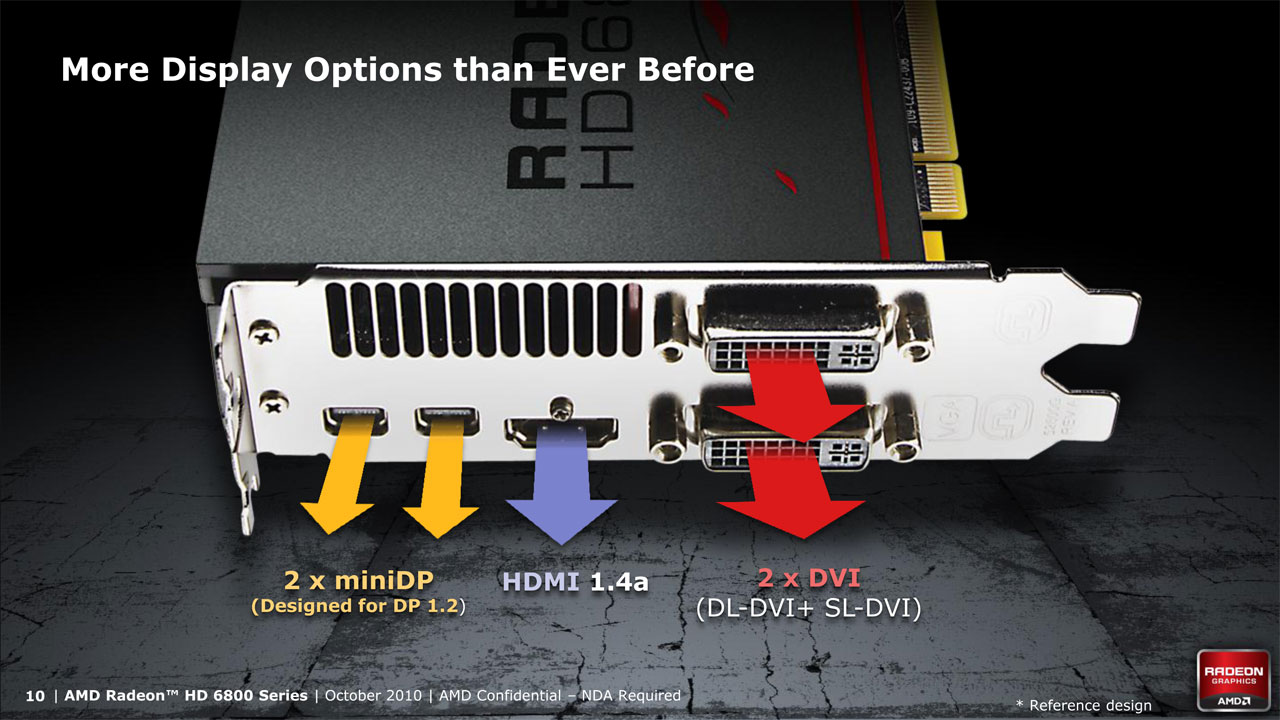AMD Radeon 6870 & 6850 Review - Architecture Updates
In addition to the refined GPU, AMD has made significant improvement to the connectors on the board. Previously the reference Radeon 5870 could only drive three displays. With the reconfiguration of the outputs, a reference Radeon 6870 or 6850 can drive six displays. A Dual-Link DVI connector requires two clock signals to drive its potentially high-res (2560x1600) output. AMD has replaced one of the DL-DVI ports with a Single-Link DVI port (which drives up to 1920x1200), freeing up one clock.
Additionally, AMD has migrated to the Display Port 1.2 standard. DP 1.2 dramatically increases bandwidth, and allows for mutliple displays to be driven from one connection. Forthcoming DP 1.2 displays will feature both a signal input (from the GPU) and an output (to another display). The DP 1.2 spec allows for one port to drive up to four displays at 1920x1200 (or two at 2560x1600).
If you don't have DP 1.2 displays (and as of today, no one does) - FEAR NOT. Currently in development are DisplayPort Multi-Stream Transport (MST) hubs. These will allow for the save 4x 1920x1200 or 2x 2560x1600 displays to be driven from the single DP 1.2 port. The one radical benefit is that the MST Hub can be create with any type of output - DP, VGA, DVI or HDMI. This means that you could pick up one Radeon HD 6870/6850 (and expectedly an HD 6900) with an MST Hub, and drive legacy monitors that don't have DisplayPort connections.
Additionally, you can still pick up an Active Single-Link DVI to Mini-DisplayPort adapter get three DVI connections.




Improved DX11, Tessellation, AA and AF
AMD released the DX11 capable Radeon 5870 several months before Windows 7 was released. Over the past year, AMD has worked to improve their DX11 performance with faster and more efficient tessellation. Their viewpoint is that per-pixel tessellation is inefficent and wasteful. Each rasterizer can tessellate 16 pixels on each pass, so to get maximum efficiency the optimum path is triangles of 16 pixels. And, how can you even make a "triangle" from a single point? With proper tessellation you not only optimize your rendering, but you also avoid overshading or producing too many polygon edges for MSAA.
In addition to improved tessellation in their second generation DX11 GPU, AMD is introducting a new AA mode is called "Morphological Anti-Aliasing". It is a post-process filtering technique that they accelerate with Direct Compute ("EyeSpeed"). This technique delivers full-scene AA (not just polygon edges or alpha surfaces), with performance similar to edge detect CFAA. AMD claims the technique is faster than super-sampling, and is compatible with DX9, DX10 and DX11.
Finally, AMD is also introducing an improved Anisotropic Filtering algorithm that addresses visible discontinuities in very noise textures. It also offers smoother transitions between filter levels.




